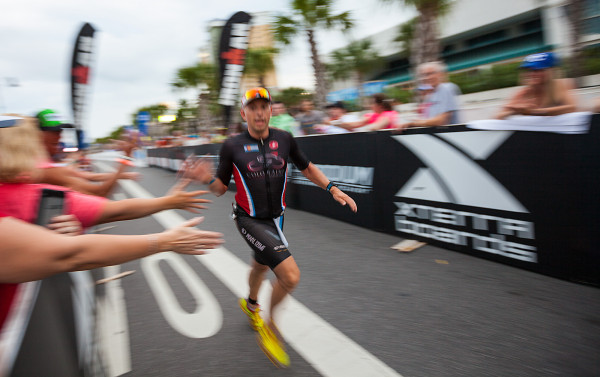We all want to run “better”, but what does that really mean? It will mean different things to different runners and triathletes. In part one of this series, I covered 7 key positions of good running form; in part two, I covered what how to run healthy. This blog post, part three, I cover 8 ways to make your run stronger.
1. Runs off the bike (OTB). In triathlon, the run is last. This means you’re always running in a fatigued state. Running strong enables you to maintain your form when tired and to run fast from start to finish. Running fast off the bike means first becoming a strong runner.
Run at a variety of paces off the bike, year round. As in any good plan, make your runs OTB general to specific throughout the season. Runs as short as 10-20 minutes will improve your ability to conquer the rubber or cement legs syndrome. Frequency and consistency over time will make running off the bike almost as seamless and fast as a stand-alone run.
I sometimes see triathletes ONLY running off the bike. I think this is unnecessary overkill and opens the door to injury. Your quality runs need to be stand-alone to get the best possible quality from your hard run training, e.g. do your hard runs when your legs are fresh. You still need to do some hard runs off the bike, just do this more selectively.
2. Improve your running form. Working to improve your running form gives you the resiliency to run fast in good form after a hard swim and bike. (See Running Better, part 1)
3. Incorporate a dynamic warm up. What you do before and after your runs will have a strong, positive impact on your ability to run strong and maintain your good form. Before the run, you want your muscles to be primed (i.e. turned on) to be able to handle the stresses of running with minimal negative impact on your body and maximal performance outcome. A dynamic warm up accomplishes this goal. Save the static stretching for after your run as this will encourage your muscles to turn off, i.e. relax and help with improved recovery. Examples of a dynamic warm up are: heel walks, knee hug/quad pull, walking butt kicks, hamstring kickouts, small, quick skips, etc. A good dynamic warm up only takes about 10 minutes, but has a big impact on a strong run.
4. Add in some running drills. Running drills for endurance runners have been adapted from drills sprinters have been using for decades. Drills help you maximize your form and teach you how to activate both your fast twitch muscle system and stability, both essential to strong running. This will give you more elastic return, i.e. help you get your foot off the ground quicker for decreased ground contact time. Examples of some running drills: A skips, running butt flicks, straight leg bound, toe up-heel up butt kicks, etc. Spending about 10-15 minutes on drills 1-3 times per is all you need. Drills can be done before, after or as part of a strength training routine.
5. Strength and conditioning, year round. It goes without saying, but I’ll say it anyway: strength training makes you stronger! Technically, by scientific definition, you get stronger when the muscle cell hypertrophies (gets bigger). Lifting weights and other strength training routines do this for you. Making the translation to running happens either consciously or by happenstance. You can incorporate run specific strength exercises such as walking lunges, step ups, runners’ lunges, biceps curls, planks, etc. Or you can strengthen the muscles and movements that are neglected when running in the sagittal plane, i.e. forward. This include movements in the frontal (side to side) or transverse (rotation) planes. Examples of these exercises are side lunges and Russian twists. Movement in these directions gives your muscles and body better overall balance and strength.
6. Run hills. Running hills helps you feel stronger overall as a runner. Run a variety of grades; 2-4% is the optimal grade to run. Remember, you need to run downhill as well. Running downhill is great for leg turnover and speed, but puts a lot of stress on your joints. As an alternative, you can do some hill running on a treadmill to avoid the downhill impact stresses. If you have a hilly race coming up or a race that’s on dirt, running hills will dramatically improve your performance on race day.
7. Get stronger on the bike. Are you a great runner, but never seem to run great on race day? You need to get stronger on the bike to showcase your running ability. Being fitter on the bike (also pacing correctly for the race distance and your fitness level) enables you to run faster off the bike. Since the majority of time is spent on the bike, it makes sense that being fit and strong on the bike is a key factor to running strong and performing at your best.
8. Mindset. Take the long- term approach to developing into a stronger runner. Small amounts of dynamic warmup, drills, strength training over time and over the course of the year will add up to helping you run strong on race day. Stay engaged and pay attention to your running form in the final miles of training and racing.
Finally, strong mind, strong body. Need I say more?
Consistency is key to running better. Without it, running better will continue to be elusive. A good training plan is a great way to achieve consistency. You’ll feel better and run better everyday.
Next up, part four: Run longer, the keys to improved endurance.
